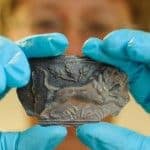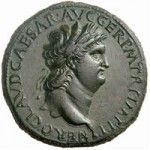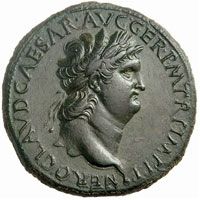Letter published on the South China Morning Post on 15.IV.2013.
Attualità
Pompey in Central London
Deep excavations under the headquarters of Bloomberg, in central London, has revealed an incredible amount of archeological finds. The slicing down through different layers of earth, 12 meters deep, has allowed to the 60 archeologists, working alongside contruction workers, to collect more than 10.000 well preserved objects. Shoes, coins, rings, phalli, pottery, writing tables, work of art. There was no volcano in London but a similar preservation work has been performed by the Walbrook Creek – one of the lost rivers of London – creating mud that has somehow protected those articles of daily life from the founding of Londinium around the year 40 AD.
An article from the Daily Mail here


Dann ist die Kacke am dampfen! (Then the shit will really hit the fan!)
If you ask to a group of politicians to design a horse you will end up with something like a camel. This is not true only for Italian politicians but for German politicians too, in spite of their fastidious lecturing pose.
Look for instance at the Willy Brandt International Airport in Berlin, after 4 target dates for the opening which were missed – the latest one is October 2013 – now the people in charge of this mess are even refusing to set a new date. There are several examples of German inefficiency to quote here. For instance it appears that officials could not figure out how to switch off the lights in the main building after switching them on. This seems to be due to a computer control system too complicated for any man to handle. So thousand of bulbs are lighting the place, day and night. There is a train connecting the city to the airport that must run every day, empty, to avoid the eight kilometers track getting rusted. Then several escalators need to be replaced because they were ordered too short or too long. Last but not least aviation experts warn that when this airport will be completed it will be too small to handle the traffic. It was designed to handle 27 million passengers a year, but last year the two city airports handled already 25 million passengers. It was estimated to cost around 2 billion euro, now after so many delays the cost has soared to about 5 billion euro. This is not a problem for a country which can borrow money at zero interest rate and with banks always ready to help politicians, especially when general elections get close. The German banking system is not only murky and messy but also State controlled. Yes, by politicians! There is a widespread misconception in Europe about German banks, believed to be very efficient and profitable. But the contrary may be true, and this could turn up to be the greatest Ponzi’s scheme in human history.
I remember talking to an Italian manager of Unicredit, after their taking over of Germany’s Hvb. He told me that it was impossible to describe the level of stupidity going on at the top managerial level of that bank. Not difficult to believe his words as was well known that Hvb was a wrack of a bank. This esplain why they sold it to Italians. If it was a good institution, Germany would have never agree to sell it. Germany has about 2000 banks, 1.100 are cooperative banks, 450 are cooperative city banks and 10 are State owned. Basically the German banking system is public, meaning owned and controlled by the Government. There are only two big private banks. Deutsche Bank, which is under investigation in the US for not having disclosed 12 billion derivative losses and in a clear breach of Basel III agreements on other matters which we’ll not discuss here. The other is Commerz Bank, which is also partially controlled by the Government after it nearly went belly up a few years ago. The German government injected 35 billion euro in it. Since then Germany has set up the Soffin Fund to bail out banks, a found that controls 450 billion euro and which is constantly very busy forking out money.
German politicians, German bankers, seem to be in control of the EC. An explosive mix indeed that should worry everybody in Europe, including German citizens. After having financed the reunification of East Germany with money drained by raising interest rates to attract fresh capital from the rest of Europe, they are now taking the high moral ground with countries like Greece, Cyprus, Spain and Italy. There is nothing to laugh about this situation, because it could trigger a financial tsunami that will push us back to the Stone Age.

Why Italian Foreign Affairs Minister Giulio Terzi di Sant’Agata Should Resign

Two Italian marines were arrested last year in Kerala, India, accused of manslaughter. Massimiliano La Torre and Salvatore Girone face an Indian law court for having shot two Indian fishermen (an accusation they vehemently deny) confusing them for pirates. The shooting took place in international waters and they should not have been tried in India. India is thus breaking international regulations. In fact the government in New Delhi had agree to appoint special Court of law to decide if they should be handed over to Italian authorities for trial.
That the Indian government considers this story a hot potato is evident. This explain why they took the unprecedented step of issuing, not one, but two licenses for them to get back to Italy, under written assurance (and a pecuniary deposit as guarantee) that they will return to India. This is not the treatment normally reserved to men suspected of murderer.
At the end of their last licence, Italian Foreign Affair Minister Giulio Terzi di Sant’Agata stepped in, declaring that they will not be handed back to India. Indian citizens, as expected, reacted with shock and dismay for having been cheated in such a lowly manner by Italy. We exchanged the high moral ground, that was our, giving it back to India. After some wrangling our Foreign Office backtracked and now the two marines are back to India, handed over by undersecretary for Foreign Affairs, Steffan de Mistura. This is a total loss of face and dignity for Italy! They did claim that assurances were given that the death penalty for the pair will be excluded. This is clearly another canard. India cannot alter its penal code to please a foreign state or one of its minister.
In a normal country Minister Terzi di Sant’Agata would have presented his resignation. This move would help to reduce the tension between Italy and India and lead to a quick resolution of this murky case. Considering that Terzi di Sant’Agata will have anyway to pack and leave in a few weeks (or a few months) with the swearing in of a new government, he could make an exit with a bang. It is highly unlikely that this former Ambassador will be reconfirmed to his ministerial post. Terzi di Sant’Agata has achieved the near impossible goal of being the worst Foreign Affair Minister since the end of WWII ,even worst than Gianfranco Fini.
Election Results at the Italian Chamber of Hong Kong
 Donatella Oliboni has been re-elected to the board of the ICC and she is now the only woman there. Donatella is also president of the Hong Kong representatives of foreign banks and financial instutitutions.
Donatella Oliboni has been re-elected to the board of the ICC and she is now the only woman there. Donatella is also president of the Hong Kong representatives of foreign banks and financial instutitutions.
and the representative for East Asia (with the exceptions of China) for the Banca Popolare di Vicenza.
Notable new entries in the ICC Board:
Cav. David Hong, of the Swank Shop. Over the years he did a lot for Italy in general and for Italian fashion in particular.
Stefano Tordiglione, a brilliant architect and designer.
Cav. Stefano Bassanese, the charming manager of Domani Restaurant. A native of Trieste he is in the board of The Dante Alighieri Cultural Society.
Election results of the Annual General Meeting of the Italian Chamber of Commerce in Hong Kong & Macao. Held on 15th March 2013 are:
Mr. Fabio De Rosa President
Mr. Christian Foddis Vice-President
Mr. Stefano Passarello Treasurer
Mr. Claudio de Bedin Corporate Secretary
Executive Committee Members
Mr. Herbert Adamczyk
Ms. Donatella Oliboni
Mr. Stefano Bassanese
Mr. Andrea Croci
Mr. David Hong
Mr. Ivano Poma
Mr. Luigi Rapetti
Mr. Stefano Tordiglione
The Italian Chamber of Commerce in Hong Kong & Macao
19/F, 168 Queen’s Road Central,
Hong Kong
Tel: (852) 2521 8837 E-mail: icc@icc.org.hk Web Site: www.icc.org.hk
‘La Bella Italia’ an article by Jason Wordie on The Sunday magazine of 10 March 2013. Italy never honored its debt with the Vatican after 1929.
Here is a letter that I posted to the South China Morning Post.
Dear sir,
Jason Wordie in his article ‘La Bella Hong Kong’ (Post Magazine 10/03) discuss about the presence of Fascist Italy in Hong Kong. In particular introducing Edda Ciano, the first born of Italian dictator Benito Mussolini, then married to Galeazzo Ciano (1903 – 1944) Consul of Italy in Shanghai from 1930 until 1933.
Indeed Edda and Galeazzo were  a very open couple, so to speak, and this is well known and documented, but that she had an affair with Chang Hsueh-liang (known as the Young Marshal) seems a great scoop made by Wordie, if true, which I doubt. As a matter of fact there is no record or hint about this. It is true however that the Young Marshal was a friend of the Ciano family and spent months in their house in Leghorn, Italy. The old people there still remember him for his love of riding at the Luna Park, screaming like a madman in the process.
a very open couple, so to speak, and this is well known and documented, but that she had an affair with Chang Hsueh-liang (known as the Young Marshal) seems a great scoop made by Wordie, if true, which I doubt. As a matter of fact there is no record or hint about this. It is true however that the Young Marshal was a friend of the Ciano family and spent months in their house in Leghorn, Italy. The old people there still remember him for his love of riding at the Luna Park, screaming like a madman in the process.
It is also not true that Italy honored the incredible amount of money that Mussolini promised to the Holy See on signing the Treaty of Lateran in 1929. Yes, it was promised, but never delivered. Italy was a poor country back then and there were pressing issues at hand, more urgent than giving millions to the pope.
Kind regards
Angelo Paratico
Here are some quotes taken from Wordie which I would like to further comment:
“Recent newspaper investigations in Europe have exposed the extent to which the Catholic Church’s secular property empire was expanded in the early 1930s. Sizeable Italian state cash injections provided by fascist dictator Benito Mussolini enabled, for example, the acquisition of a large and extremely valuable central London property portfolio. But for decades, unsurprisingly, a thick veil of secrecy surrounded these commercial holdings and how they were secured. In 1929, Mussolini concluded a concordat, or “peace treaty”, with the Catholic Church. Internationally known as the Treaty of the Lateran, this agreement regularised relations between the church and the Italian state after nearly six tense decades following the unification of Italy, in 1871. As is often the case in religious affairs, underlying economic and political realities were more significant than any spiritual explanation would suggest. After unification, the church had lost control of the central Italian regions hitherto known as the Papal States – and the significant revenue that those territories generated.”
Not true – likewise false the article published in London – saying that Italy paid a large amount of money to the Vatican in fact Italy never paid what was promised in the treaty. The war in Ethiopia (1935 – 1936) and the sanctions imposed by the League of Nations bled white Italy’s finances. Then there was the civil war in Spain, which opened a larger hole into which Italy sunk the last available gold. This explain why Mussolini got even closer to Nazi Germany, which was providing coal and oil to Italy. When Italy entered the war on 10 June 1940, because Italy had no other viable choices, due to British unwillingness to compromise, Mussolini was certain that it will last for only 3 weeks. Italian soldiers had not enough bullets for their rifles, the navy had provision for 3 months.
Another myth worth dispelling is that was Mussolini who declared war. In fact was King Victor Emanuel III as Italy was still a Monarchy. Without the constant approval in writing by the King, Mussolini had no real powers.
Wordie again:
“…a shadowy businessman and bullion broker named P.G. Calcina, lived in Hong Kong for decades and eventually died here in the 1970s.”
So shadowy indeed that no one remember him, was he really Italian? By a quick search on google I can find that he worked for Jardine Matheson before the War, that his daughter studied at St. James School in Malvern, England and then university in New York after the war. The girl married an American Navy officer in 1956, an aide to John Cassady, Commander of the 6th Fleet. Was he really a shadowy Italian or a shadowy British double agent pretending to be Italian? I can’t say for sure.
“Edda lengthiest liaison was with Chang Hsueh-liang, the “Young Marshal” of Manchuria. A handsome, game-for-anything playboy (and former heroin addict), “Peter” Chang – as he was known within his wide circle of foreign friends – and the vivacious, free-wheeling Edda hit it off very well. So well, in fact, that the latter spent months at a time in Hong Kong, discreetly and apparently ecstatically ensconced at the Repulse Bay Hotel with Chang and his entourage.”
This is pure fantasy. Chang was courted by Galeazzo Ciano, not Edda, and for political reasons. Ciano invited him to stay in Livorno. That Edda and Galeazzo had several affairs is true but I don’t think that Galeazzo would take a lover of Edda, the mother of his children, into his home if he had suspected an affair with her. This was against the ethos of the fascist man, as he pretended to be. Not to forget that while in Shanghai she got pregnant and delivered her first son, Fabrizio. Guglielmo Marconi set up a special radio connection Rome-Shanghai to let grandfather and grandmother talk with her.
The British Secret service concocted a story according to which Galeazzo Ciano had a sexual liaison with the double divorced Bessie Wallis Warfield later known as Wally Simpson, making her pregnant. According to this file Simpson, on the way back to England, stopped in India to have an abortion that rendered her barren. They presented this false report to King Edward VIII to convince him to give her up. Edda had always denied this story, admitting all the other infidelities. In fact she said that in Shanghai she discovered the womanizer nature of Galeazzo and contemplated suicide, wanting to jump from the terrace at the Park Hotel in Nanjin Road. But then she tought that instead of killing herself she will pay back her husband with the same money. In spite of this subsequently she tried everything to have him freed in 1944 and never spoke or forgave her father for not having pardoned him. In fact Mussolini would have gladly spared Galeazzo’s life, but his hands were tied. All the shots in Italy were called by Hitler and Hitler had always hated Galeazzo Ciano.
A Literary Agency specialized in Asian Authors.
A new literary agency has been created in Hong Kong by Kelly Falconer, a dynamic editor and writer. Prior to founding the Asia Literary Agency, Kelly Falconer spent twelve years as an editor in London and Hong Kong, working for various publishers including Weidenfeld & Nicolson, Granta, Constable & Robinson and Virgin Books. She was the literary editor of the Asia Literary Review in 2012.
Here is her company manifesto:
The Asia Literary Agency was founded in 2013, at the tail end of the year of the dragon.
 The Asia Literary Agency represents Asian writers, experts on Asia or writers living in Asia. We are conveniently based in Hong Kong, which gives us immediate access to this vast region, and we are selling to the rest of the world including the USA, the UK, Europe and Asia. We are also handling foreign rights for the Hong Kong-based publisher, Typhoon Media. We care about our authors and their futures, and aim to help them build their careers and flourish.
The Asia Literary Agency represents Asian writers, experts on Asia or writers living in Asia. We are conveniently based in Hong Kong, which gives us immediate access to this vast region, and we are selling to the rest of the world including the USA, the UK, Europe and Asia. We are also handling foreign rights for the Hong Kong-based publisher, Typhoon Media. We care about our authors and their futures, and aim to help them build their careers and flourish.
Here is the link:
http://asialiteraryagency.org/index.php/authors
Did St. Catherine Loved a Spy? Her secret work for the temporal power of the pope and for John Hawkwood, English Condottiere.

June 1375, Piazza del Campo of Siena. A capital execution is going to take place in a few minutes under the wat

chful eyes of thousand of citizens. A round wood block is visible in the center, placed on a raised platform. The executioner is waiting, axe in hand. Then the spectators see a pale, thin, figure of woman rising unsteadily on the platform; she kneels and put her head on the block. No one move, holding the breath, a puzzled executioner looks around, seeking orders.
That lady was Saint Catherine of Siena. She was born in 1347 as Catherine Benincasa in Via del Tiratoio, near Piazza del Campo. Since she was very young she was greatly attracted to ascetic life; to the Medieval harsh ascetism, with all the repulsive overtones that we are no longer willing to bear – today a psychiatric test will be advised on such a girl– but she was possessed by a striking passion, that made her transcended and transform everything. Catherine was illiterate but she was dictating her letters, still in print today, that made her rise to become one of the greatest mystic of all times. She was taken by many for a living saint.
Modern readers of her letters are still impressed, 650 years later, because they contain a mix of violence, veiled eroticism and very pious feelings. In 1363 she had emerged from her cell, where she had spent three years in solitude, beginning her political career. Thank to her angiographer, Raimondo da Capua, a sort of press agent ante litteram who started to write about her in 1385, five years after her death, we know a bit more about her, but it is a very partial view.
Then, after Catherine, the real condemned man came up on the platform, and when he saw Catherine he laughted. She rose, speaking softly and caressing him, then she helped put his neck on the block and crouched close-by. The executioner’s axe rose and fell producing a hollow sound. Catherine took the severed man’s head into her hands, and then kissed the man’s lips, splashing her dress and face with his blood. All the bystanders stood in silence, hypnotized but what they were witnessing. Catherine calmly went down the block and walked home, keeping the men’s blood on her for weeks, refusing to wash.
Who was that man? We know that Saint Catherine met him several times in his prison cell and there is agreement among historians about his identity: he was Nicolò di Toldo, from Perugia.
Gerard de Puy, vicar general of the Papal States had tried to save his life, asking for leniency, but he failed because the accusations against him were rock solid. He had been condemned to death because he was accused, and found guilty, of sowing discord in Siena, in few words he was a spy planted to spread political subversion. A death sentence in Siena in those days for such crimes was indeed rare, unless a real murderous plot had been discovered.
It is highly likely that Saint Catherine of Siena was also involved in this papal plot to regain control of the rebellious city, but due to the fame of her sanctity she was left unmolested. There are also strong connections between Saint Catherine and John Hawkwood (to Italians his name was unpronounceable and for this reason they called him Giovanni Acuto) an English mercenary, running for decades a very successful mercenary company in Italy, mainly composed of British and German soldiers specialized in pillaging villages and cities.
At that time Hawkwood was on the side of the Pope, but in the past and, again, in the future fought against the Holy See. All depended on his personal interests. He was a very shrewd and successful soldier of fortune who had drifted south after having fought in France during the Hundred Years War, just after the treaty of 1360 who brought a lull of unwanted peace to the soldiers. He had married a daughter of Bernabò Visconti, master of Milan, and had been able to keep a spot-clean reputation even after the massacre of the civil population of Cesena in 1377, a shocking episode even for the low standards of the time, which did cost the life of 4.000 to 6.000 innocent people, murdered in cold blood. They were thrown out of their bed during a night-raid and put to the sword. John Hawkwood was so successful in his long career that he was finally buried in the Duomo of Florence, in 1394, under a splendid fresco painted by Paolo Uccello.
It is certain that St. Catherine conspired against the Sienese government together with the Salimbeni, a very powerful family, papal partisans with castles and towers in Maremma and Val D’Orcia, together with her mentor and biographer, Raimondo da Capua. An old Florentine chronicler, writing about Saint Catherine, noted: “She was esteemed like a prophet by some, but by the others she was held to be a hypocrite and a wicked woman.”
International Society for Neronian Studies Publishes my Essay on Cardano.

My essay on the publication of the Neronis Encomium by Girolamo Cardano has been reprinted by the only review dedicated to Neronian Studies.
Here is the link:
http://www.sien-neron.fr/neronia-electronica-revue-electronique/
1. Lincoln, a movie by Steven Spielberg. 2 An Italian Map in the movie. 3 Abolition of slavery by Doge Pietro IV for Christian slaves. 4 Garibaldi received an offer from Lincoln to become the Commander in Chief of the Northern Army. 5 An Interview with Arrigo Petacco.

This film is a historical drama, first released in 2012. It is also now shown in Hong Kong’s cinemas, after receiving two Oscars in Hollywood: for best actor and for best production design. Apparently this was a great success for Spielberg but it was below his expectations, even if the costumes and the acting by Daniel Day-Lewis (Lincoln) were indeed superb. About historical accuracy opinions are mixed but, generally speaking, there is a consensus that Spielberg tried his best to stick to facts.
The story around which the movie revolves is about the struggle put up by Abraham Lincoln to have the XIII amendment enshrined into the American Constitution, to outlaw slavery and involuntary servitude. It was adopted by the US Senate on December 6, 1865.
This is a very ‘American’ movie intended mostly, I believe, for home consumption. In fact slavery was abolished earlier in Europe than in the US were such blemish on their honor was erased too late, only after an horrible war.
Italian Connections
As a matter of fact the first Country to abolish the slave trade – but when Christians were involved – was Venice, under Doge Pietro IV Candiano. This happened in June 960. Nine hundred years before Lincoln and, by sheer coincidence, the twentieth Doge of the Venetian Republic suffered a fate similar to that of the 16th President of the United States. Pietro IV and his son were murdered near San Marco Square and their bodies thrown into a slaughterhouse. Later they were picked up and buried in Sant’Ilario Church.
At the beginning of the movie the spectators see a color map showing a Country, the US, split in two by the warring factions. This map is in fact Italian, as it can be clearly see by the legenda put on its left side. Probably Spielberg could not find an old map as detailed as that but made in the US.
Another connection, unknown to the general public, is the fact that Abraham Lincoln asked general Giuseppe Garibaldi to take command of the Northern Forces at the beginning of the war, but Lincoln’s offer was turned down by Garibaldi because, somehow, Lincoln was unable to offer Garibaldi’s the guarantee he had requested. This point is futher explained in the following article, published by The Guardian on 8 February 2000.
A frayed postcard in a Turin archive has revealed one of the most audacious gambles of the American civil war. Abraham Lincoln offered the command of the northern forces to Giuseppe Garibaldi, who had unified Italy.
The US president, his forces hammered by the Confederate army, turned in desperation to Garibaldi, spawning one of the greatest ‘what if’ in history.
Rumours of Lincoln’s offer have circulated for a century had been denied by American scholars, but a document proves it was no just a myth, said Arrigo Petacco, a historian.
He stumbled across the faded blue postcard, from Garibaldi to King Victor Emmanuel II telling the king about the offer, last week while rummaging in 90 boxes of material donated by Italy’s exiled royal family.
Garibaldi caught the world’s imagination in 1860 after invading Sicily with 1,000 lightly armed red-shirts. They defeated 12,000 Neapolitan troops, took the island and, determined to unify the Italian peninsula, invaded the mainland. They occupied Naples and unleashed a wave of support.
According to Mr Petacco, the rebel, who in the 1850s had led an army in Uruguay and travelled through the US, was also a mason. The international masonic lodge successfully lobbied for him to be granted American citizenship.
Garibaldi was ready to accept Lincoln’s 1862 offer but on condition, said Mr Petacco: that the war’s objective should be set on the abolition of slavery. But at that stage Lincoln was unwilling to make such a statement lest he worsen their agricultural crisis.
“Later they offered Garibaldi the command of one unit, rather than the whole army, but at that point it was too late and he had gone on to do other things,” Mr Petacco said. “In Italy we always knew, but there was always a lot of scepticism in America. Now we know for sure.”


